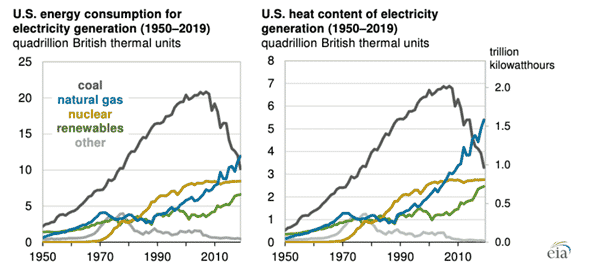Conversion Losses Accounted for Over 60 Percent of Power Sector Energy Consumption in 2019: EIA

U.S. utility-scale power generation facilities used 38 quadrillion British thermal units, or quads, of energy to provide 14 quads of electricity in 2019, according to a July 21 report from the U.S. Energy Information Administration. Much of the difference is attributed to losses during the conversion process. In presenting this statistic, the industry at large is confronted with a plethora of questions surrounding the efficacy and pragmatism of power plants that operate in a wasteful manner.
Coal-powered plants are, on average, significantly older than their natural gas counterparts, and therefore require one-third more energy to provide one kilowatt-hour of electricity. Of the 11.9 quads consumed by natural gas plants, 5.4 quads of net electricity was generated, or 45 percent of energy input. By comparison, coal-fired plants accounted for 10.2 quads of consumption, generating 3.3 quads of net electricity, or 32 percent of energy input. The report also states that natural gas was not ubiquitous as an electricity provider until the past decade — it overtook coal as the leading source of energy for electricity generation as recently as 2019.
In recent decades, the power generation mix has shifted to a more diverse portfolio of fuels, including natural gas and renewables. The increase in natural gas plants that use combine-cycle generation techniques to produce electricity has proven to improve average efficiency across fossil-fuel fired plants.
The report also states that 96 percent of the 13.3 quads produced in the U.S. last year powered residential, commercial, transportation, and industrial uses, while the remaining 4 percent was utilized by production facilities themselves. The residential and commercial sectors accounted for 75 percent of all retail electricity sales.
EnerKnol Pulses like this one are powered by the EnerKnol Platform—the first comprehensive database for real-time energy policy tracking. Sign up for a free trial below for access to key regulatory data and deep industry insights across the energy spectrum.
ACCESS FREE TRIAL